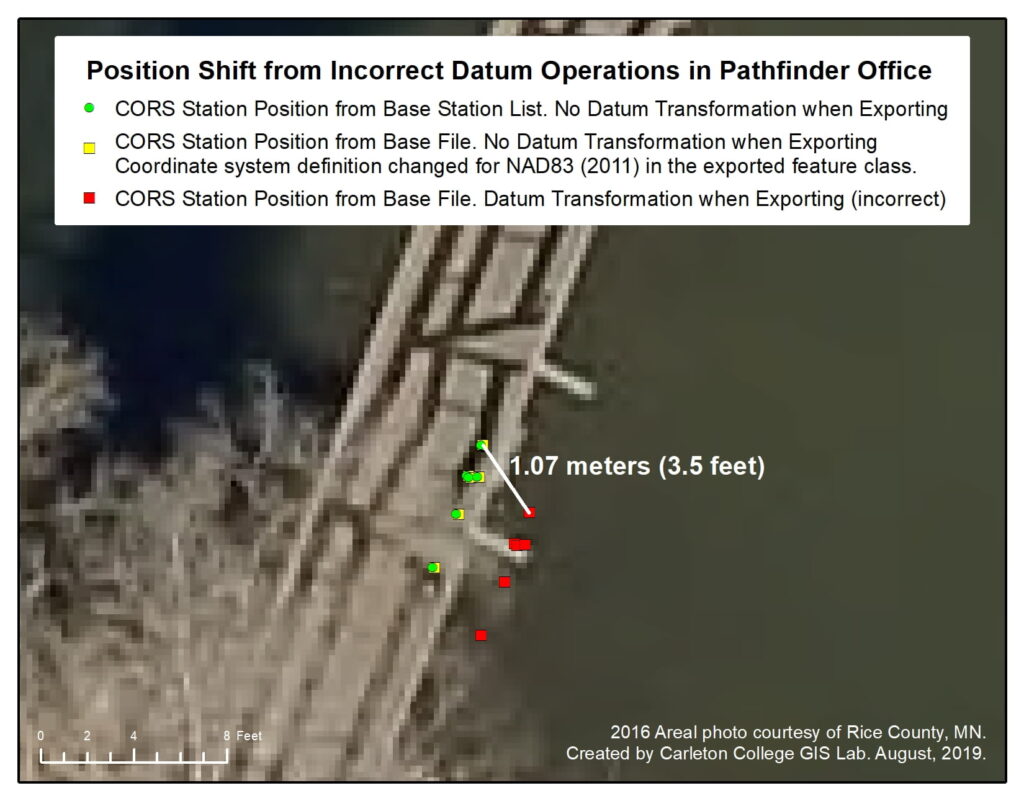

If PFO output (the shapefiles you mention are considered "truth"), then I have a suggestion to do the right thing when it comes to "holding" a CORS solution. So, if its not too late, or too far back, I have two comments on the precise terms you use when you wrote what your doing in PFO. I'm experienced in Trimble workflows including Pathfinder Office and have fought my way out of the datum tidal flats more than i can mention. May I chime in on the first layer of the onion that I see in this original question. Another possibility is to run the GEOCON transformations (there's a beta v2.0 as well) using the NGS converters to see what the offsets look like in your area of interest. Or just use them to get the HARN data up-to-date. You could take HARN as approximately equivalent to CORS96 and chain together the 1st transformation above, with We don't have equivalent equation-based transformations because NGS hasn't released any.

HOW TO GET GPS PATHFINDER OFFICE TO EXPORT PRJ FILE PRO
The files are also in a separate install, 'ArcGIS Coordinate System Data' or 'ArcGIS Pro Coordinate System Data' as the data files were getting too large to include with the core software. GEOCON is file-based, so I don't think Collector supports them. I sometimes link a ITRFxx version with WGS84 in the transformation name, as a hint to which realization the transformatoin applies to.Īt 10.4, we added support for GEOCON v1.1 which converts between the "last" HARN re-adjustment and NSRS2007 or NSRS2007 to 2011. That will change in an upcoming release, as EPSG plans to add them. So far we are not differentiating between the WGS84 realizations. If this is the case, then there's really no method or transformation in the Project geoprocessing tool that would enable me to reproject my NAD_1983_CORS96 GPS data into NAD_1983_2011, correct?Īs far as Collector goes, if the data is coming in as ITRF 2008 based on the SBAS correction source, if I overlay it with NAD_1983_CORS96 or NAD_1983_HARN, etc., what's the best transformation to use? Or does it really not make a difference if they're all treated as equal as far as ArcGIS is concerned?įinally, maybe I just haven't come across the details on this yet, but when ESRI references GCS_WGS_1984, which WGS 1984 are they referring to? Is the reference to G1762, which is the latest realization, or is this in reference to G1674 or G1150? I realize that these are all based on ITRF and should all be within 10cm/4", but I'd like to #1 understand what ESRI is referring to and #2 be able to select the most accurate transformation settings for the data. I'm using ArcGIS Desktop 10.3.1, and by looking at the transformations list published with each release of desktop, it appears that the transformations between NAD_1983_HARN, NAD_1983_CORS96, and NAD_1986 (original/1986) are equivalent or simply "bookkeeping". This means that I have data in 3 different datums or realizations in regards to the NAD83 GPS points.

Now, I have a Collector app that is using SBAS corrections, so the data is in ITRF 2008 (essentially equal to WGS84 within 10cm/4"), if I'm not mistaken. However, I continue having a difficult time pinpointing exactly which transformations I should use.Įssentially, I have GPS data that was post processed against the local CORS stations in Pathfinder Office using the reference position from base provider option, which depending on the date and station would be ITRF00 or ITRF08 and exported as NAD83 CORS96 and in later years as NAD83 (2011).

I realize there are already many questions and answers out there related to this issue.


 0 kommentar(er)
0 kommentar(er)
